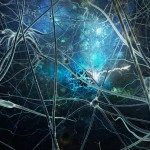Link to Pubmed [PMID] – 15024001
J. Biol. Chem. 2004 May;279(21):22704-14
Mitochondria modulate Ca(2+) signals by taking up, buffering, and releasing Ca(2+) at key locations near Ca(2+) release or influx channels. The role of such local interactions between channels and organelles is difficult to establish in living cells because mitochondria form an interconnected network constantly remodeled by coordinated fusion and fission reactions. To study the effect of a controlled disruption of the mitochondrial network on Ca(2+) homeostasis, we took advantage of hFis1, a protein that promotes mitochondrial fission by recruiting the dynamin-related protein, Drp1. hFis1 expression in HeLa cells induced a rapid and complete fragmentation of mitochondria, which redistributed away from the plasma membrane and clustered around the nucleus. Despite the dramatic morphological alteration, hFis1-fragmented mitochondria maintained a normal transmembrane potential and pH and took up normally the Ca(2+) released from intracellular stores upon agonist stimulation, as measured with a targeted ratiometric pericam probe. In contrast, hFis1-fragmented mitochondria took up more slowly the Ca(2+) entering across plasma membrane channels, because the Ca(2+) ions reaching mitochondria propagated faster and in a more coordinated manner in interconnected than in fragmented mitochondria. In parallel cytosolic fura-2 measurements, the capacitative Ca(2+) entry (CCE) elicited by store depletion was only marginally reduced by hFis1 expression. Regardless of mitochondria shape and location, disruption of mitochondrial potential with uncouplers or oligomycin/rotenone reduced CCE by approximately 35%. These observations indicate that close contact to Ca(2+) influx channels is not required for CCE modulation and that the formation of a mitochondrial network facilitates Ca(2+) propagation within interconnected mitochondria.

